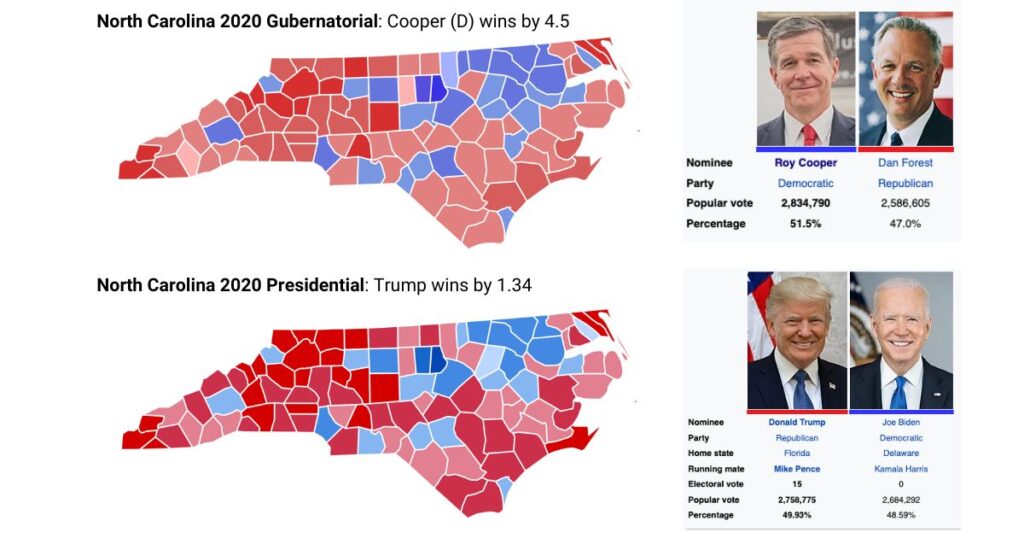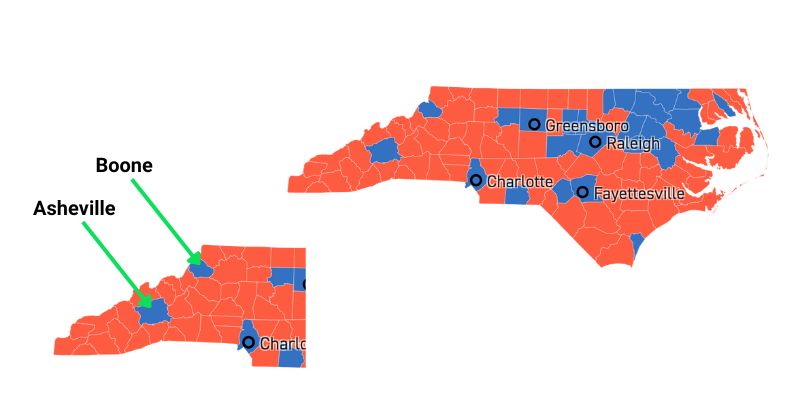
As the clock ticks down to 2024 Election Day, North Carolina is arguably the most problematic swing state for political analysts and pollsters to predict an electoral outcome confidently. Even before Hurricane Helene wreaked havoc on North Carolina’s residents and infrastructure, the Tarheel State’s regional differences posed unique challenges for former President Donald Trump to prevent Kamala Harris from flipping the state blue.
Trump eeked out a win over Biden by 1.4% in 2020, with 50.1% of the vote to Biden’s share of 48.7%. Throughout Biden’s re-election campaign, Trump enjoyed a polling lead average that was around 5% most months. Since Biden’s exit and Kamala Harris entrance, the most recent polls show Harris with a small lead or in a virtual tie with Trump.
In statewide races, Democrats haven’t won a US Senate seat or won the majority of votes for president since 2008, but North Carolina Governor Roy Cooper is a Democrat who upset incumbent Republican Gov. Pat McCrory in 2016, and held off Republican Lt. Governor Dan Forest in 2020, despite a firebrand conservative Republican, Mark Robinson, being elected as Forest’s successor as Lieutenant Governor. In this cycle, Robinson is running for Cooper’s vacant seat as a heavy underdog against current North Carolina Attorney General Josh Stein, who has maintained a double-digit lead over Robinson in major polls throughout the majority of the race.

On social issues, most of the rural counties are comprised of conservative Christian Republicans, yet North Carolina is the one that started the national debate over opening women’s bathrooms to transgender individuals. Democrats can rely on strong support for social issues in Charlotte and college towns.
North Carolina’s demographics can be analyzed in 4 different sections
- Western North Carolina: Home to the majority of rural voters who reliably vote conservative but two counties that are heavily populated by academic professionals and college students who typically vote Democratic. (Similar to Leon County and Alachua County in Florida, home to Florida State University and the University of Florida, respectively.)
- The Research Triangle: A mixture of academia and medical professionals.
- Charlotte Metro Area: The largest city in the state, which votes for Democrats by a reliably wide margin. Despite the fact that the city is home to major banks, it remains a dark blue region since many of fiscal conservatives who work in the banking industry commute from South Carolina, just south the state’s border.
- Eastern North Carolina: Tourism thrives along the coastal community, along with upstart small businesses launched by young investors in cities such as Wilmington.
An influx of former New York residents also complicates the grand picture. More North Carolina transplants were born in New York than in any other state. Since the COVID pandemic, Democratic strongholds gained the most new residents from New York. Mecklenburg County is home to the state’s largest city, Charlotte, where Biden won more than twice as many votes as Trump in 2020, with 66.9% of the vote to Trump’s 31.7%). Mecklenburg has the most residents who are natives of New York, with approximately 87.7 thousand in the most recent count by UNC Chapel Hill’s Carolina Population Center.
When the Rochester, NY-based chain Wegmans opened its first store in Raleigh, more than 3,000 people lined up for the grand opening.
Throughout North Carolina, 46% of all residents were born outside North Carolina — accounting for nearly 5 million people, according to Carolina Demography at the University of North Carolina. Of those, about 10% (about 518,000 people) were born in New York, the leading birthplace of those born outside North Carolina.
By comparison, in 1980, about 23% of residents were born outside North Carolina.
Wake County, home to Raleigh and North Carolina State University (NCSU), has the second-highest number of NY natives, with approximately 78.7K. In 2020, Biden got 62.5% of the votes, while Trump got 35.9%. Wake County is part of the region known as “The Research Triangle”, neighbored by Orange County and Durham County, where UNC’s campus overlaps. Duke University is located in Durham, just over 10 miles northeast of UNC. If you combine that number with Orange and Durham counties, the Research Triangle, as a whole, would be No. 1, Nathan Dollar, director of Carolina Demography, told Axios.
Counties with the next largest shares of new residents include:
- Guilford County: Biden won by just over 23 points, 61% to 37.8%
- Forsyth County: Biden won by just under 14 points, 56.3% to 42.4%,
- Harnett County: Trump won by 22.5 points, 60.5% to 38%.
One of the most closely-contested counties is Pasquotank County. In 2020, Biden won with 49.5% of the vote to Trump’s 49.2%, with third party candidates getting the remainder.
EDUCATION LEVELS AND THE “DIPLOMA DIVIDE”:
Across the nation, education level is the new leading indicator of a voter’s intent to vote for Trump or Harris. The Lumina Foundation has a report that uses census data to rank states by educational attainment, including post-high school certifications and associate degrees. It’s true that most of the battlegrounds – Pennsylvania, Michigan and Wisconsin in the Rust Belt and Georgia, North Carolina and Arizona in the Sun Belt – all fall near the average. There is also one important exception. Nevada, which is a battleground state, has one of of the lowest levels of educational attainment in the US. While most of the states with the highest educational attainment are blue states in the northeast, Utah, a red state, is also near the top of the list.
According to federal data released by Lumina Foundation, Adults in North Carolina are earning more degrees and credentials. Lumina’s annual Stronger Nation report shows 54.4% of working-age adults (ages 25 to 64) in North Carolina have earned a postsecondary degree or credential of value, roughly equivalent to the national attainment rate of 54.3%. The report is based on data from the U.S. Census Bureau’s American Community Survey in 2022.
North Carolina’s credential attainment rate increased 2.3%, making it one of three states along with Washington, D.C. to see an increase of at least 2% from 2021 to 2022. Since 2009, North Carolina’s educational attainment rate for 25 to 64 year-olds has increased by 16.5%.
Blue Counties that will play a pivotal role in the 2024 Election:
Watauga County is 83% white, but Biden won by 8.3 points, 53.3% to 45%. It is home to Appalachian State University, and was one of the counties that was hit the hardest by Hurricane Helene.
Buncombe County: As many Americans recently learned from tragic Hurricane Helene footage, Buncombe County is home to Asheville, and is a deep blue county, where Biden defeated Trump by more than 20 points, earning 59.74 of the vote to Trump’s 38.64, and the remaining voters opting for a third party candidate or not voting for any presidential candidate. Asheville, often described as a “deep blue spot in a dark red state”, could be considered North Carolina’s version of Austin, Texas. Eleven colleges are located in the Asheville metro area, and US Census data shows 48.3% of Buncombe County residents have attained a bachelor’s degree or higher level of education.

Hoke County: This county went blue by double digits in 2020, with Biden earning 54.6% of the vote to Trump’s 43.8% and the remainder voting for a third party or not voting for president. Approximately 40.4% of the county is white, 32.2 percent as black, 14.8 percent as Hispanic or Latino, and 7 percent as Native American, remarkably higher than most counties across the nation. According to the 2021 American Community Survey, an estimated 19.8 percent of county residents have attained a bachelor’s degree or higher level of education.
Pitt County has voted blue since 2008. In 2020, Biden won by just under a ten-point margin, with 54.1% of the vote to Trump’s 44.6%. The county’s racial demographics are 51% white, 35% black, and hispanics make up 8% of residents. According to US Census data, 33.1% of Pitt County residents have attained a bachelor’s degree or higher level of education.




